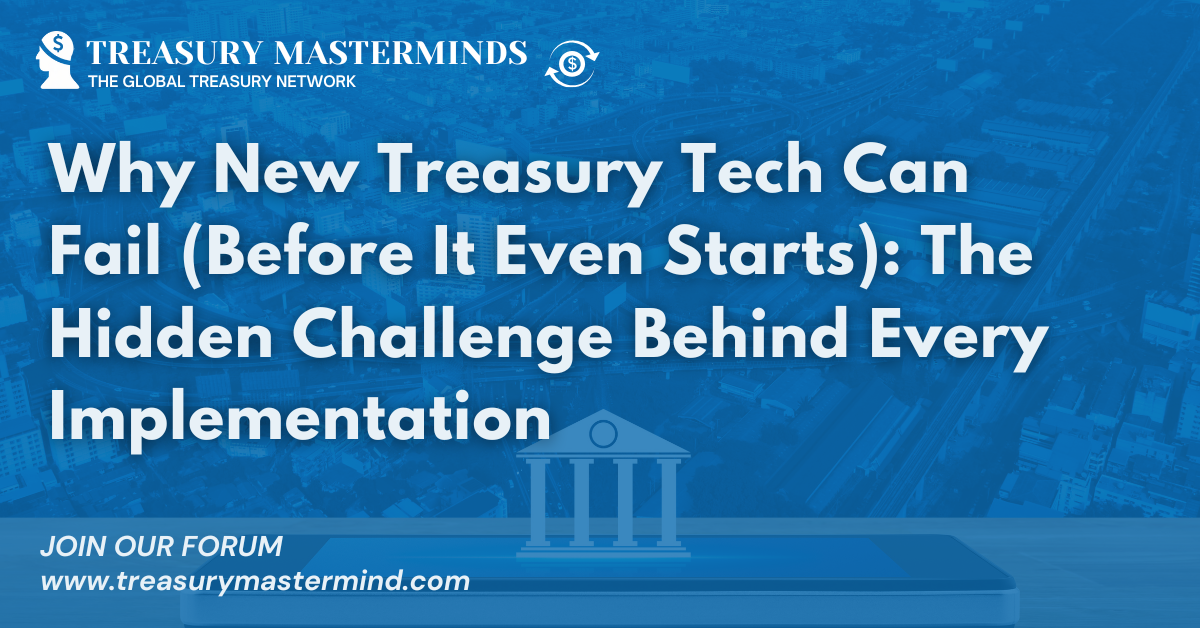
Resistance to change trumps cost, integrations, and tool choice — here’s what that means for your treasury transformation.
When it comes to implementing new treasury technology, we often focus on the big-ticket issues — budget approvals, ERP integrations, selecting the best vendor. But if our latest Treasury Masterminds poll is any indication, the real challenge is something more human: resistance to change.
We asked the community, “What is the biggest challenge you face when adopting new treasury technology?” and here’s what they told us:
- Resistance to change – 45%
- Integrations – 23%
- Choosing the right tool – 18%
- Costs/Budget – 11%
- Training staff – 2%
The result? Nearly half of treasury professionals said that resistance to change is their top challenge — far above anything technical or financial.
So why is change so hard?
Let’s face it: treasury teams are often lean, busy, and already running mission-critical processes. Introducing new tech means a temporary dip in efficiency, a learning curve, and the fear that something might break.
But beneath the surface, resistance often comes from:
- Fear of the unknown: Will the new tool make my job harder? Will it make my job obsolete?
- Change fatigue: After years of ERP upgrades, system migrations, and process overhauls, people are tired.
- Lack of involvement: When end-users aren’t part of the decision-making, the new tool feels imposed, not empowering.
Real-World Lessons from Treasury Tech Implementations
1. FoxMeyer’s ERP Implementation: A Cautionary Tale
In the mid-1990s, FoxMeyer, a pharmaceutical distributor, embarked on an ambitious ERP implementation aiming to automate its warehouse operations. However, the company adopted a “big bang” approach, rolling out the new system across all operations simultaneously. This rapid transition, coupled with inadequate training and unrealistic expectations, led to significant operational disruptions. The system couldn’t handle the volume of transactions, leading to order fulfillment issues. Ultimately, the failed implementation contributed to FoxMeyer’s bankruptcy.
Lesson: Gradual implementation and thorough training are crucial. A phased approach allows for adjustments and reduces the risk of widespread disruption.
2. Resistance Masking Deeper Issues: A Case of Fraud
A case study highlighted by The Global Treasurer discusses a company that sought to optimize its payables process by transitioning from manual checks to electronic payments. The accounts payable manager resisted the change, citing minimal time savings. However, after implementing a new ERP system, it was discovered that an employee had been manually writing checks and embezzling funds for over a decade. The resistance to change had masked fraudulent activities.
Lesson: Resistance to change can sometimes conceal deeper issues. It’s essential to investigate the root causes of resistance to ensure transparency and integrity.
3. Siemens AG’s Successful Transition to Real-Time Treasury
Siemens AG undertook a significant transformation to implement real-time treasury operations. This shift required integrating various systems and processes to enable instantaneous data flow and decision-making. The transition was complex, involving technological upgrades and cultural shifts within the organization. Despite the challenges, Siemens successfully enhanced its liquidity management and operational efficiency.
Lesson: Comprehensive planning, stakeholder engagement, and a clear vision are vital for successful large-scale transformations.
Strategies to Overcome Resistance
- Involve Stakeholders Early: Engage team members in the decision-making process to foster ownership and reduce apprehension.
- Communicate the Benefits: Clearly articulate how the new technology will alleviate pain points and improve daily operations.
- Provide Adequate Training: Ensure that staff are well-equipped to use the new systems confidently.
- Implement Gradually: Adopt a phased approach to allow for adjustments and minimize disruptions.
- Monitor and Address Concerns: Establish feedback mechanisms to identify and address issues promptly.
Conclusion
Adopting new treasury technology is not just a technical endeavor but a human one. Recognizing and addressing resistance to change is crucial for successful implementation. By learning from real-world examples and proactively engaging stakeholders, organizations can navigate the complexities of transformation and unlock the full potential of modern treasury solutions.
Also Read
- Data is the new liquidity: Why Treasurers must champion technology for better data management
- You’re Doing Payments Wrong—And It’s Costing You Strategic Control
- Do You Have a Right to a Bank Account? Here’s How It Works for Individuals and Businesses
- The Role of Treasury: From Operational to Strategic Leadership
- The Evolution of Treasury: How Has the Role Changed in Recent Years?
- The Modern Treasurer: A Strategically Skilled Financial Leader
- The U.S. Finally Catches Up to the Rest of the World on Payments
- CBDC vs Stable Coin for Treasurers
- Physical vs. Virtual Bank Accounts: What You Need to Know
- Treasury needs to be it’s own DOGE
- Applying Hedge Accounting for Your FX Hedging: A Checklist, Tips, and Tricks
- Understanding Bank Treasury: Managing Liquidity, Risk, and Regulatory Compliance
- Challenges in Payment Operations: Insights from Modern Treasury’s Survey
Join our Treasury Community
Treasury Mastermind is a community of professionals working in treasury management or those interested in learning more about various topics related to treasury management, including cash management, foreign exchange management, and payments. To register and connect with Treasury professionals, click [HERE] or fill out the form below to get more information.